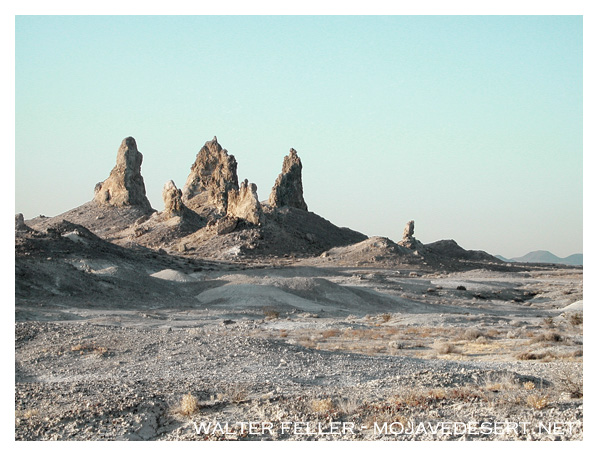
A new chapter in the history of Mojave Desert mining and transportation came into being -- one which was to play a tremendous part in the economic life of the past as well as the present.
While mining in the Slate Range, John and Dennis Searles found borax crystals on the salt-encrusted surface of the huge dry lake which now bears their name. This was in 1862. Unknowingly, they had discovered the richest deposit of diversified chemicals the world has known.
Not until a decade later did actual mining operations get underway, when the pioneer San Bernardino Borax Mining Company was founded.
An acute problem facing the Searles was transportation. Heavy wagon or trains were put into use and they plied back and forth to Mojave over what is generally called the Searles Lake - Mojave Road. Stations were established at intervals, principal of which was Searles Station an important supply point. The route followed the present Trona Railroad to Searles Station, where it divided, a winter course going down the canyon via this site of Garlock. In the summer, to avoid deep sand, it circled north near present Inyokern and then continued south through Red Rock Canyon
Almost simultaneously, with the beginning of borax operations at Searles Lake, the discovery of borax deposits in Death Valley attracted attention. In 1881, Aaron Winters found cottonball borax near Furnace Creek, a deposit developed by William T Coleman, who, in the following year, started the Harmony Borax Works, which later became a part of the Pacific Coast Borax Company. Confronted with the formidable task of hauling the borax over 165 miles of desert to Mojave, the now famous fleet of special wagons were built. Drawn by 20 mules (in most instances 18 mules and two horses), they made the trip over Wingate Pass, past Grant Wells, and across the desert south of the present Atolia. Thus, the Death Valley - Mojave borax road became another vital link in the network of routes in this desert region.
With the completion of the Southern Pacific line over the Tehachapis to Mojave in 1876, freighting time to Los Angeles was greatly expedited. This applied as well to the Mojave - Needles branch finished in 1882, which ran through the Boron area, in a trade of railroad trackage, the Santa Fe took over this line 2 years later.
By the end of the 1880s mining at Darwin, Coso, Cerro Gordo and Panamint had all but ceased. The Kramer gold district held the spotlight for a very brief period in 1884. The early 1890s witnessed some activity in the Goler mining district in the El Paso Range.
Previous - 1 - 2 - 3 - 4 - 5 - 6 - 7 - 8 - Next